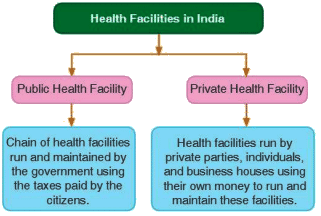Year 13 Exam > Year 13 Notes > Sociology for A Level > Chapter Notes: Role of Government in Healthcare
Role of Government in Healthcare Chapter Notes | Sociology for A Level - Year 13 PDF Download
| Table of contents |

|
| Introduction |

|
| Role of Government in Healthcare in India |

|
| Distribution of Resources |

|
| Financing Healthcare Services |

|
| Types of Health Facilities in India |

|
| Access of Resources to Communities |

|
Introduction
According to the World Health Organization (WHO), health is defined as a state of overall physical, mental, and social well-being, and not just the absence of illness or disability. A person is regarded as healthy when they are not suffering from sickness or injury. Various factors affect an individual's health, such as access to clean drinking water, adequate nutrition, proper sleep, cleanliness in the environment, and low levels of pollution.Health in India
- Since the 1990s, neighbors like Nepal and Bangladesh improved human development faster than India
- 2014 UNDP Report: India lags behind most neighbors in health and quality of life indicators
- In 1995, Bangladesh, Nepal, Bhutan, and Pakistan had worse infant mortality rates than India
- By 2010, all except Pakistan surpassed India's infant mortality rate of 48 per 1,000 live births
- Most neighboring countries (except Pakistan) spend more of their national income on public healthcare
Role of Government in Healthcare in India
- Government, private organizations, and NGOs work to prevent and treat illnesses
- Facilities like health centers, hospitals, clinics, laboratories, and mobile dispensaries are provided
- Free medical aid, consultancy, and medicines are offered to the poor
- India has a universal healthcare system where states provide basic amenities
- Government, as a welfare state, has a social and moral duty to provide healthcare to all
- Special care is given to vulnerable groups like children, women, elderly, and people with special needs
- Efforts are made to reduce poverty and inequalities for better healthcare access
- Awareness campaigns promote preventive actions, self-care, and risk reduction
- 'India for Safe Food' movement ensures access to safe, toxin-free food
- Wealthier groups demand advanced, affordable medical facilities
- Poorer sections struggle to access costly services
- Government faces challenges of unequal access, poverty, and resource distribution
- Cost-effective health services and diverse medicinal systems are provided through public programs
- Indigenous practices and community volunteers are involved in healthcare delivery
Distribution of Resources
- State governments make laws on public health, water, and sanitation
- At independence, healthcare was urban and clinic-based with limited rural access
- Planning Commission assessed resources and planned their use through Five-Year Plans
- Efforts included training and addressing major health problems
- Life expectancy rose from 50 years to over 64 by 2000
- NITI Aayog, established in 2015, replaced the Planning Commission
- NITI Aayog encourages state participation in economic policy-making
- It acts as a think-tank, involving villages in development to support deprived sections
Paradox-Resources and Facilities Available
- India’s large population provides significant manpower as a human resource
- India has many medical colleges, hospitals, doctors, and exports medical equipment
- Despite resources, many lack medical care due to insufficient facilities, distance, poor transport, or lack of professionals
- Diseases like TB, cancer, malaria, and waterborne illnesses (dysentery, jaundice, hepatitis, diarrhea) affect millions
- Waterborne diseases account for 21% of communicable diseases
- Undernourishment and malnutrition threaten children, with nearly half under three underweight
- Over half of women and children are anaemic
- Programs like ICDS, National Mid-day Meal Scheme, National Rural Health Mission, and PDS address under-nutrition
Financing Healthcare Services
- Taxes fund public services like healthcare, police, defense, highways, education, and judiciary
- Tax money supports development, disaster response, and research in medical, nuclear, space, and military fields
- Government ensures medical facilities, food, education, and housing, especially for the poor
- Public health infrastructure relies on tax revenue
Types of Health Facilities in India
Health facilities are divided into public (government-run) and private (run by individuals or businesses)
Public Healthcare System
- Consists of state-owned facilities funded and controlled by the government
- Ministry of Health and Family Welfare forms health policies and improves public health
- Treatments are fully or partially subsidized
- Awareness campaigns, like the 2011 National Anti-Tobacco Youth Campaign, aim to eradicate diseases
- Special care is provided for economically weaker and vulnerable groups
- Government ensures the right to life by providing timely medical aid
- Citizens can approach courts if deprived of medical facilities
Private Healthcare System
- Private healthcare refers to medical services provided by entities other than the government.
- In India, private healthcare costs are among the lowest globally, yet they remain unaffordable for most citizens.
- According to World Bank data, 99% of India’s population cannot afford private health services.
- The Indian healthcare system attracts a million patients from abroad annually.
- However, many Indian citizens are pushed into poverty each year due to healthcare expenses.
- Despite government checks and available medicines, private healthcare institutions remain costly and inaccessible to the average person.
Medical Tourism
- India’s low-cost, high-quality medical services attract lakhs of medical tourists yearly
- Treatment costs are about one-tenth of those in other countries
- Government eased visa restrictions, allowing 30-day stays for medical reasons
- Hospitals employ translators for patients from Balkan, African, and Gulf countries
Access of Resources to Communities
- Directive Principles of State Policy guide Central and State governments to ensure social welfare
- These principles aim to provide adequate livelihood, equal pay, support for the sick, aged, unemployed, and disabled, maternity relief, and improved nutrition and public health
- Public health expenditure is shared by Central and State governments
- NGOs and WHO assist public healthcare programs
- State governments are responsible for public health
- NRHM provides medicines, equipment, and training to rural health workers
- Medicines are offered free or at low cost
- Poor healthcare access negatively impacts India’s human resources
Case Study: Kerala
- In the 1980s, Kerala faced health issues like infectious diseases, lifestyle diseases, and mental health challenges
- Kerala People’s Campaign for Decentralized Planning (1996) gave 35-40% of the development budget to local governments
- Public healthcare institutions were transferred to local governments
- Improved sanitation and safe drinking water were provided
- Primary and secondary healthcare facilities are now well-equipped
- Special projects address needs of the terminally ill, autistic, differently-abled, aged, and others
- Local governments respond to specific health needs
- Challenges include dual control by Panchayats and health departments
- Most Panchayats received Nirmal Puraskar, but environmental sanitation and waste disposal need improvement
Case Study: Costa Rica
- Costa Rica, the healthiest country in South America, has no army, redirecting funds to health and education
- Government provides water, food, education, sanitation, and housing to all citizens
- Health education is integrated into all levels of education
- Public and private health facilities exist, with public centers funded by the government
The document Role of Government in Healthcare Chapter Notes | Sociology for A Level - Year 13 is a part of the Year 13 Course Sociology for A Level.
All you need of Year 13 at this link: Year 13
|
133 docs|13 tests
|
FAQs on Role of Government in Healthcare Chapter Notes - Sociology for A Level - Year 13
| 1. What is the role of the government in healthcare in India? |  |
Ans. The government plays a crucial role in healthcare in India by formulating policies, providing funding, and ensuring access to healthcare services for all citizens. It regulates healthcare standards, oversees public health initiatives, and implements programs aimed at improving the overall health of the population.
| 2. How is healthcare financed in India? |  |
Ans. Healthcare in India is financed through a mix of public and private sources. The government allocates a budget for public health services, while individuals often pay out-of-pocket for private healthcare. There are also health insurance schemes aimed at providing financial assistance for medical expenses, particularly for vulnerable populations.
| 3. What types of health facilities are available in India? |  |
Ans. India has a diverse range of health facilities, including government hospitals, private hospitals, clinics, primary health centers, and specialized healthcare institutions. These facilities cater to different levels of care, from basic outpatient services to advanced surgical procedures.
| 4. How does medical tourism impact healthcare in India? |  |
Ans. Medical tourism significantly impacts healthcare in India by attracting international patients seeking affordable and high-quality medical treatments. This influx of patients boosts the economy, promotes the development of healthcare infrastructure, and raises the standards of medical services available in the country.
| 5. Can you provide an example of effective healthcare in a specific region, like Kerala? |  |
Ans. Kerala is often cited as a model for effective healthcare in India due to its robust public health system, high literacy rates, and strong community involvement. The state has achieved impressive health indicators, such as low infant mortality and high life expectancy, through comprehensive healthcare programs and effective resource management.
Related Searches




















